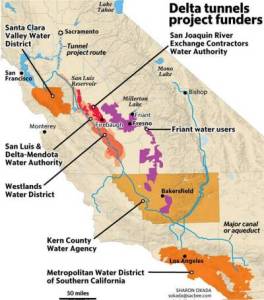 One of the least discussed issues in California environmental politics – and one of the most crucial to understanding Governor Jerry Brown’s Delta Tunnels Plan – is the clear connection between the Marine Life Protection Act (MLPA) Initiative and the California WaterFix, formerly called the Bay Delta Conservation Plan (BDCP).
One of the least discussed issues in California environmental politics – and one of the most crucial to understanding Governor Jerry Brown’s Delta Tunnels Plan – is the clear connection between the Marine Life Protection Act (MLPA) Initiative and the California WaterFix, formerly called the Bay Delta Conservation Plan (BDCP).
At a time when local, national and international mainstream media are focusing on the Oroville Dam crisis, it’s important for reporters to dig deeper and understand the context that the emergency, which spurred the evacuation of over 188,000 people in Butte, Yuba and Sutter counties, occurs within.
It’s crucial to understand that these two neo-liberal processes, the MLPA Initiative and the California Water Fix, are the environmental “legacy” that two Governors, Arnold Schwarznegger and Jerry Brown, have devoted their energy, staff and money to, rather than doing the mundane but necessary process of maintaining and repairing the state’s water infrastructure, including Oroville Dam.
The privately-funded MLPA Initiative and the California WaterFix at first may appear to be entirely different processes.
The MLPA Initiative, a process begun in 2004 under the Schwarzenegger administration, purported to create a network of “marine protected areas” along the California coast. The network was supposedly completed on December 19, 2012 with the imposition of contested “marine protected areas” along the North Coast under the Jerry Brown administration.
On the other hand, the Bay Delta Conservation Plan process began under the Bush and Schwarzenegger administrations to achieve the so-called “co-equal goals” of water supply reliability and Delta ecosystem restoration. In 2015, the state and federal governments divided the BDCP into two projects, the California WaterFix, the conveyance component and the California EcoRestore, the habitat “restoration” component.
But in spite of some superficial differences, the two processes are united by their leadership, funding, greenwashing goals, racism and denial of tribal rights, junk science and numerous conflicts of interest. When people educate themselves on the links between the two processes, I believe they can more effectively wage a successful campaign against the Delta Tunnels and to restore our imperiled salmon and San Francisco Bay-Delta fisheries.





 California Governor Jerry Brown today joined Oregon Governor Kate Brown and Washington Governor Jay Inslee in condemning Trump’s plan to expand oil and gas drilling in federal waters – at the same time that California regulators under Brown have expanded offshore oil drilling by 17 percent in state waters.
California Governor Jerry Brown today joined Oregon Governor Kate Brown and Washington Governor Jay Inslee in condemning Trump’s plan to expand oil and gas drilling in federal waters – at the same time that California regulators under Brown have expanded offshore oil drilling by 17 percent in state waters. Growers in the massive district, located on the west side of the San Joaquin Valley, cited the high cost of the state-federal proposal as their reason for rejecting the project. Politically powerful Westlands is the largest irrigation district in the country.
Growers in the massive district, located on the west side of the San Joaquin Valley, cited the high cost of the state-federal proposal as their reason for rejecting the project. Politically powerful Westlands is the largest irrigation district in the country. “Three recent federal audits have found the U.S. Bureau of Reclamation misspending more than $100 million in funds but the agency has not committed to any meaningful reforms nor to punishing any responsible officials,” according to Public Employees for Environmental Responsibility (PEER).
“Three recent federal audits have found the U.S. Bureau of Reclamation misspending more than $100 million in funds but the agency has not committed to any meaningful reforms nor to punishing any responsible officials,” according to Public Employees for Environmental Responsibility (PEER).